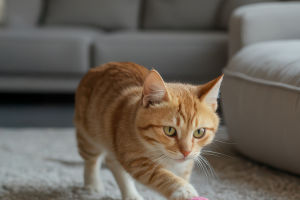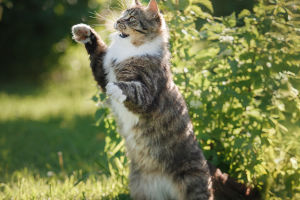If you've ever scrolled social media and seen a photo of someone grinning beside a furry creature with an almost human-like smile, chances are, you've met the quokka—at least virtually.
Often called "the world's happiest animal", the quokka has become a photo sensation. But beyond the viral selfies lies an incredible species, with its own challenges, adaptations, and a very particular relationship with people and conservation.
What Is a Quokka?
Quokkas are small marsupials—relatives of kangaroos and wallabies—found almost exclusively in Western Australia. They're about the size of a domestic cat, weighing 5 to 11 pounds (2.27 to 4.98 kg) and standing around 16 inches (40 cm) tall.
Their fur is a grizzled brown, their ears are round, and they're best known for their expressive mouths, which curve up at the edges and make them look like they're always smiling. But their charm goes beyond looks.
Why Are Quokkas So Friendly?
There's a reason quokkas seem unusually chill around humans.
1. They lack natural predators on their main habitat
Quokkas are mostly found on Rottnest Island, off the coast of Perth. This island is free of natural predators like foxes or large wild cats. As a result, quokkas have evolved to be unusually trusting—and even curious—toward humans.
2. Their behavior is rooted in survival
That friendly attitude? It's not just nature—it's also strategy. On a small island with lots of tourists, being approachable helps them access food and water (though it's illegal to feed them). Over time, they've become more used to people than their mainland relatives.
Dr. Elaine Masters, a wildlife biologist who has studied marsupials for over 20 years, explains: "Quokkas have adapted to live alongside humans without the usual fear response. This makes them perfect for ecotourism, but also more vulnerable to harm if people don't respect their space."
Selfie Craze: Good or Bad?
If you visit Rottnest Island, you'll quickly notice one thing: people lined up to take a quokka selfie. The photos are charming—often with a quokka smiling up into the camera, tourists beaming beside it. Even celebrities like Chris Hemsworth and Margot Robbie have posted their own versions.
But not everyone sees this as harmless fun.
1. Feeding isn't legal and a mistake
Many tourists try to lure quokkas with food for the perfect shot. This can cause serious health issues, including digestive blockages and bacterial infections. Rangers routinely patrol popular selfie spots and fine people who break the rules.
2. Stress isn't always visible
Though quokkas look happy, they don't always feel happy. Their body language is subtle, and signs of distress—like tail flicking or shallow breathing—often go unnoticed by selfie-seeking crowds.
Visiting Rottnest Island: What to Know
Rottnest Island is the epicenter of the quokka craze—and for good reason. It's a stunning island with crystal-clear beaches, protected natural areas, and of course, the largest population of wild quokkas.
1. Getting there
Ferries run daily from Perth or Fremantle, with round-trip prices averaging $45–60 USD per adult. The journey takes about 30 minutes.
2. Best time to visit
Spring (September to November) and autumn (March to May) offer mild weather and fewer crowds. Quokkas are most active in the early morning and late afternoon.
3. Tips for a responsible visit
• Don't touch or feed the quokkas
• Use selfie sticks rather than crouching too close
• Observe quietly and patiently
• Carry water and wear sunscreen—there's minimal shade on parts of the island
4. Ticket prices & hours
Entry to the island itself is free, but ferry and bike rental fees apply. Bike rental: about $25 USD/day. Island shops and restaurants are open from 8:00 AM to 5:00 PM.
The Conservation Story Behind the Smile
As adorable as they are, quokkas aren't doing great everywhere.
1. Mainland populations are declining
While Rottnest quokkas are thriving, mainland populations have dropped due to habitat destruction and introduced predators like foxes and cats. Conservation efforts are underway, but progress is slow.
2. Fires and climate change
Australia's increasing bushfires and drier conditions also threaten quokka habitats. In 2015, a single fire in Two Peoples Bay wiped out 90% of the local quokka group there.
3. Ecotourism as a double-edged sword
Tourism funds conservation—but also puts pressure on wildlife. Rottnest Island management now uses strict visitor guidelines, fines, and ranger patrols to balance tourism with protection.
What Quokkas Teach Us About Joy and Balance
It's tempting to believe that quokkas smile because they're happy—and to some extent, that's how they make us feel. But their story reminds us that what looks joyful on the outside can come with real responsibility.
They show us the value of gentleness, the importance of boundaries, and the power of presence. When you sit near a quokka—no phone, no noise—you start to see life at a slower, simpler rhythm.
So, if you're ever lucky enough to meet a quokka in person, take a moment before snapping that selfie. Let it come to you. Watch its movements. And when it looks up at you with that unmistakable expression, remember: the smile is real—but so is the need to protect it.
Have you ever taken a wildlife selfie that changed how you saw the animal? Or do you think viral fame helps or hurts species like the quokka?

